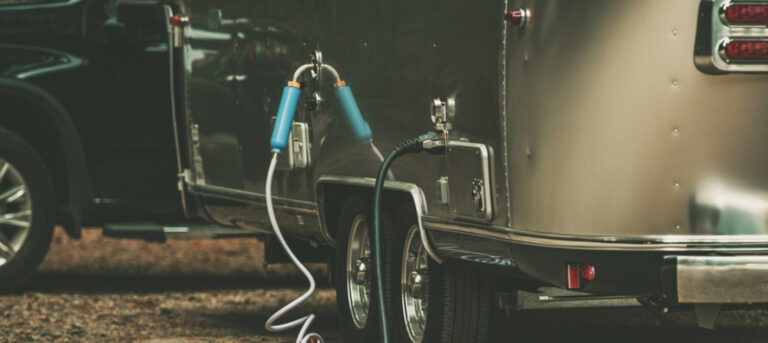
There are some instances when it’s just nice to be able to use your RV on your own land. Maybe you have friends coming to visit and would like to give them their own place to stay. Perhaps you’d like to use your trailer or motorhome as an office. For this reason, many are left wondering, “Can I install RV hookups on my property?”
Fortunately, you absolutely can. The next questions are how much will this cost and how to install RV hookups on property.
RV Hookup Cost
Now that you know how to install RV hookups on property, let’s talk about money. The cost to install RV hookups on land can vary quite a bit. In the end, the total will depend on 1) how much work you’re able and willing to do on your own, 2) how many amps your RV requires, 3) the type of sewer system you’re working with, 4) how far from your house you’d like your hookups to be, and 5) where you live.
- Cost to Install an RV Water Hookup: Around $30 if DIY; around $700 if not.
- Cost to Install an RV Electric Hookup: Around $1,200 for a professional install.
- Cost to Install an RV Sewer Hookup: Free (or extremely cheap) for use of current sewage disposal system; $2,000–$3,000 for RV-specific septic tank.
So how much does it cost to install RV hookups? The true answer is that the cost can vary wildly, but you’ll be looking at an investment of anywhere from $200–$300 for a DIY job, to a few thousand dollars for a professional to do the work.
How to Install RV Hookups at Home (Step-by-Step)
Want to save a few bucks on RV hookup installation cost by doing the work yourself? Good plan! Most of this project is pretty straightforward and can be done by any moderately handy individual with a good bag of tools.
Here’s how to install RV hookups on property.
1. Create a Parking Pad
The first step is to create a parking pad for your RV. The goal is to have a level surface that can support the weight of your RV should the ground become very wet. Gravel and cement both work well.
Your pad should be at least 4 feet wide and long enough to comfortably accommodate your rig and then some. Make sure there are no low-hanging branches or power lines over your pad, and consider the distance to your house and how that will affect your water and electric hookup installation.
2. Install a Post
Once your pad is in place, a hole should be dug to hold a post securely in place. The hole should be about 8 inches wide and 30 inches deep. Place a 4’x4’ post into the hole and pour concrete around it to hold it in place.
This pole will hold your electric and water hookups, so it should be placed on the driver’s side of the RV.
Note: It’s important to contact utility companies before digging in your yard. This will ensure you avoid existing gas, water, and power lines, saving you money and possibly your life.
3. Put In Your Water Hookup
Putting in a water hookup is a relatively straightforward process. Dig a trench below the frost line from your water source to your post, then run a high-rated CPVC pipe through the trench, connecting it to the water supply and securing it well.
Wrap the exposed waterline with heat tape to prevent freezing, secure the water line to your post using pipe clamps, fill the trench with cement, and cover the trench with dirt. Add your faucet to your water line, and now you have a water hookup!
4. Turn to the Electricity
Next, you’ll need to consider the electric hookup. While this can be done by a very knowledgeable individual who has experience working with electricity, this isn’t a job for the average joe. Therefore, we recommend calling an electrician if you don’t already have the know-how to get this step done.
Whoever installs this hookup will need to be aware of what type of plug your rig uses: 30-amp or 50-amp. The ‘heads’ of these cables have different and specific prong layouts, so you’ll want to make sure a compatible one is put in place.
5. Finish with Sewer
Last but not least, you will need a sewer hookup. In some cases you may not need to install anything at all.
How do I hook up my RV to my house sewer?
If your home is connected to a public sewer system, you likely have a cleanout in your yard. As long as it’s legal in your area, you can pop the cap off this cleanout and hook your RV up to that—though if you’re far away from it, you might need a really long hose and a macerator pump to move the sewage along.
How do I hook up my RV sewer to my septic tank?
If you have a septic tank, the process could be just the same. However, you may find that there isn’t a cleanout to dump into. In this case, you may need to install a 4-inch pipe upward and out from the septic tank in order to give yourself something to dump into.
Can’t use either option above? Wondering how to install RV sewer hookup at home? The final option is to add an RV-specific in-ground septic tank. This is both expensive and much more difficult. Therefore, we only recommend it as a last resort. If this is what you need to do, you will likely want to bring in a contractor to bury the tank, and you will definitely need to bring someone in to pump that tank from time to time.
Don’t love any of these sewer options? You might consider switching to a composting toilet.
Can You Hook an RV Up to a House?
Now you know how to install RV hookups on property, but let’s say you don’t have the time, money, or skills to install RV hookups in your yard. Could you just hook your RV up to a house? Well yes, but there are some things you should know first.
If you have an outlet on the outside of your house, you absolutely can plug your RV into it. The thing is, it is likely only a 15- or 20-amp outlet. Since all RVs are made to plug into either a 30-amp or 50-amp outlet, and since the plugs for these types of outlets are different from one another, you will need to invest in an adapter in order to plug your RV into a regular house outlet.
Additionally, because the house outlet will only put out 15 or 20 amps, you will not be able to run everything in the RV. In many cases, you won’t be able to run the air conditioner at all without tripping a breaker, and even the microwave is questionable. But yes, as long as you’re able and willing to limit what you run, you can hook an RV up to a house outlet.
What about water though? Well sure, you can absolutely connect a fresh water hose to your house water spigot and hook that up to your city water inlet. You could alternatively use that outside water source to fill your fresh tank and simply use that water while parked in your yard. Either way, getting fresh water into your RV when parked next to your house is a cinch.
The last hookup is sewer, and we discussed how to connect your sewer hose to the city sewer system or a home septic tank already. That said, you do really want to make sure it is legal to dump into the city sewer if that is the route you plan to take.
One way to offset the cost to install RV hookups? Listing your RV for rent with RVshare! Earn income from your RV when you aren’t using it.

